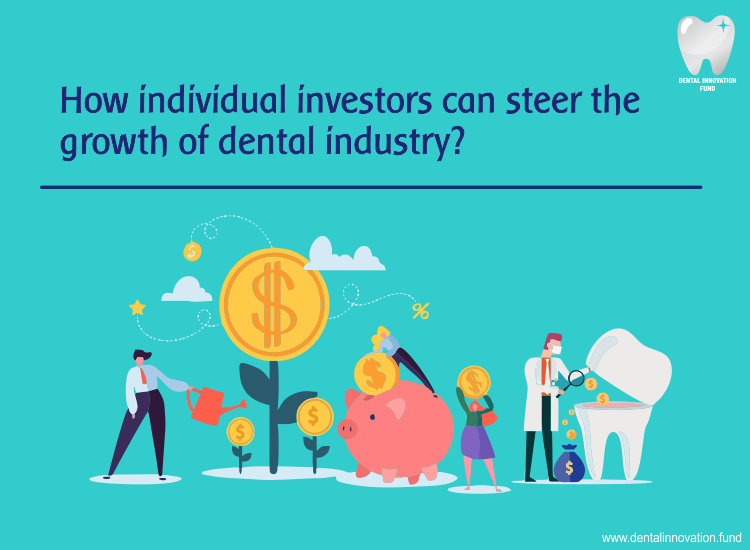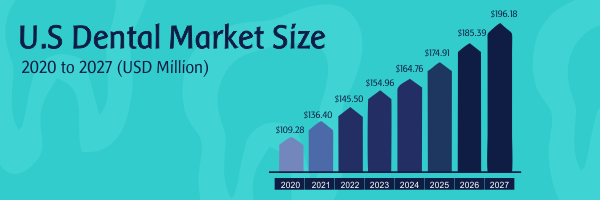
How individual investors can steer the growth of the dental industry?
Individual dental investors can bring massive changes to the dental care industry. With digitization dental investments can bring fruitful results for the investors.

The US dental market is expected to increase at a CAGR of 6.24 percent between 2021 and 2027, from the US $ 13.64 billion in 2021 to US $ 196.18 billion in 2027. The elderly population is a major element driving market expansion.
The aging population in the US is increasing by 15% every 10 years. As people age, their mouths shrink, causing issues including loose dentures, edentulism, dry mouth cavities, periodontal disease, and even oral cancer. In actuality, the average age of those diagnosed with oral cancer is sixty-two years old.
The dental market in US generates around $ 25 billion in yearly sales worldwide and continues to be a hub for mergers and acquisitions. This year has seen a flurry of initial public offerings (IPOs), bringing dentistry stocks back into the spotlight.
A Quick Outlook on the growth of Dental Funds
Dentsply Sirona (XRAY) and Align Technology (ALGN), two dental manufacturers, are among Business Insider's 15 predictions for the top performers on the S&P 500 in 2019. Along with micro-manufacturers circuit and biotechnology, as well as online payment system providers, these two dental companies have been identified as a possible investments.
Medical care is required in all economic situations, and individuals will forego more expenditure to save for their health. You may, however, put off unneeded therapy. Dental companies are more vulnerable to consumer behavior than other healthcare firms.
Dental inventory has been mixed thus far in 2019. While growing macroeconomic instability in financial markets is harming the dentistry industry, we also find that investors are becoming increasingly concerned about the increased direct pressure dental enterprises are facing from rivals.
The dentistry industry's areas of competence are expanding, and the market-leading enterprises that serve these sectors are prospering.
Changes in the population impacting the future workforce:
As the population grows, dentist demand is likely to rise, and people may maintain their teeth longer and require more care later in life.
Aside from population increase, the demographics of the population are changing as the baby boomer generation retires and the population gets younger.

The young demographic, who benefited from water fluoridation, preventative dental education, and greater dental insurance coverage, predicted that the number of dental visits per person and the efficiency of bookings would decline in the future.
Aside from population increase, the demographics of the population are changing as the baby boomer generation retires and the population gets younger.
The young population of the United States, which has benefited from domestic defluoridation, preventive dental education, and extensive dental coverage, has predicted that the number of dental visits per person, as well as the booking efficiency, will decrease in the future.
Fluoride, which has been extensively used for decades, and improving oral health standards have had a substantial influence on oral health advances during the last 50 years and will determine the field's future. These advancements in oral health are critical factors in minimizing the time it takes to maintain a patient's oral health.
Dentists provide dental treatments such as prevention, treatment, and diagnosis of dental problems. The rise in the incidence of dental illnesses such as periodontitis and tooth decay is propelling the dental services industry forward.
The increasing knowledge of dentistry in US, the increasing acceptance of laser dentistry, the growing demand for cosmetic dentistry among young people, and the improvement of technology in dentistry are some of the key factors driving the advancement of dentistry while developing the global dental services market.
The dentistry profession has encountered significant hurdles in preserving and restoring this enormous quantity of thoroughly repaired teeth during the previous few decades.
Since then, birth groups have seen far less tooth damage as children and young people, necessitating significantly less treatment per capita and overall.
All dentists will be able to keep the oral health of more of these healthy patients in less time by 2040. Dentists will spend less time per patient by 2040 than the typical adult in the United States. This is because the aged cohort with more severe care demands is replaced by a young and healthy generation.
Another trend that can affect the future of dentists is a compulsory insurance for children's dentists in private health insurance.
Although increased pediatric dental coverage has boosted the current demand for pediatric practitioners, as more children are insured, the need will level off. While pediatric dentists continue to have opportunities to treat vulnerable and disadvantaged people, it is unclear whether the revised payer model will be beneficial in better supporting these patients.
How do dental investments provide investors with a safe haven?
Many new Challenger Banks have emerged, and they are one of the greenest areas for lenders, eager to help industries that must be active in the longer term.
In unsafe political conditions, investor and bank funds tend to follow a regulated needs-based sector where the level of business turmoil has historically been modest.
By combining the introduction of private dentistry with manual skills, dentistry addresses these needs and provides business owners the opportunity for organic growth.
Dental market trends in 2021-22:
The oral health market in US is growing increasingly focused on quality and geographically sensitive. Due to persistent issues in finding and maintaining staff, urban demand is growing, particularly among corporate purchasers. Because it is a general functioning concept, independent purchasers are less susceptible to it.

Better Quality practices:
Average prices climb in lockstep, although higher costs reflect improved quality practices. In the NHS, quotes are increasingly based on actual contract performance rather than contract amounts.
The performance of NHS contracts is directly influenced by employee recruitment and retention. In the NHS sector, split markets are forming. Practices that are well-placed and/or managed and have a consistent UDA performance are sold at a considerable premium.
Remote areas with a history of poor performance, on the other hand, are now sold based on actual performance rather than the contract value. The net rate of return decreases as operating costs rise.
Shifting Demand for Private Dentistry:
There has been a marked change in demand, especially from companies and owners of multiple clinics to the private sector. It aims to offset the risk of future phased contract reforms, mitigate net reductions in NHS funding, and increase working-level revenues.
Several firms are now giving cash incentives to dental office sellers. This can help buyers and sellers match their objectives and can be an efficient approach to adding value in a growing market.
Bank support:
In comparison to many other businesses, dentistry provides a safe refuge for banks and other investors. While private dentistry can be seen as a matter of discretion, restrictions on treatment by the NHS mean that demand for private dental care remains strong even in difficult economic conditions.
Many people, on the other hand, have seen and adapted to the fast-changing landscapes of recent years. In the last couple of years, we have seen the rise of the private dental sector and the patient's desire to pay for better care rather than relying on the NHS.
Most private clinics and dentists see a steady increase in fee income regardless of projected income. Lenders used to favor NHS-based clinics, but they are increasingly willing to lend to unexpected private dental practices as well. Your sole need is that, based on the patient list, the outbound, income accounting customer has an agreed commitment for a fair amount of time.
What are the top Dental innovation trends that are steering the market growth?
When there is a pandemic, expenditure on the pandemic is considerably decreased.
Indeed, the Health Policy Institute projects that dental spending in 2021 will be $ 123.9 billion, only 80% of pre-pandemic levels.
To cut expenses and fulfill changing patient requirements, dentistry is increasingly adopting new technology.
Continue reading to learn more about dentistry market developments through 2022:
Dentists Invest In 3D Printing:
From 2021 to 2028, the worldwide 3D printing market is predicted to expand by 21%. Dental clinics will be able to get 3D printed stuff at a lesser cost as 3D printing technology becomes more common.
According to the Journal of the American Dental Association, the low-cost and straightforward workflow of additive 3D printing has the potential to improve the precision and efficiency of clinical dentistry in both academic and private practice.
Today, many dental practices can meet your 3D printing needs in-house or at a more reasonable cost.
Dental practices continue to consolidate:
Solo practice in dentistry is continue to be declining – a very good sign for dental investors. Two out of every three dental clinics operated alone in 1999, according to the American Dental Association. Furthermore, from 1.54 in 2000 to 1.88 in 2015, the average practice size grew.
In addition to group practices, another strategy is to take root and join the Dental Services Organization (DSO) and Dental Management Services Organization (DMSO).
DSO and DMSO work with dental businesses to provide administrative and non-clinical services such as human resource development, accounting, and supplier negotiations. In 2017, the DSO included 7.4% of all dentists in the US.
What are the main factors driving the industry to integration! Finance
In the case of a pandemic, according to a recent study of dentists, 7% of dentists are considering joining a DSO or combining their practice, which sparks greater opportunities for dental investors.
Digital marketing is important for a dental practice:
Dental practices have generally been tiny businesses with little resources for internet marketing. Although it is taking time to catch up, the epidemic highlights the importance of internet advertising for many dental practices.
More marketing, according to a January 2021 dentist study, would make their business more productive and lucrative. Digital advertising spending will reach $ 389 billion in 2021 across all businesses, representing a 17 percent increase.
One-third of dental patients feel a dentist can't function without Facebook marketing, according to a poll. Patients prefer to view video content from the dentist's clinic, according to the study.
Social media has become a popular and inexpensive way for dentists to reach out to new patients.
Up till 2013, only 86.2% of businesses (including the dental practices).
However, in 2022, businesses are expected to use social media in 92.1 percent of cases.
The new automated practices in the dental industry:
Remote dentistry might make it simpler for 20% of rural Americans who don't have convenient access to dental and medical facilities to get care.
Furthermore, remote dentistry has been demonstrated to be just as effective in identifying caries and reviewing treatment options as a first-hand consultation.
Automation will become the standard for many dental practices in the future years for appointment scheduling, customer service, and other management duties.
The healthcare Chatbot industry is predicted to expand 23 percent by 2025, reaching a market value of USD 733.2 million, thanks to improvements in artificial intelligence. Many crucial services may be provided by dental chatbots.
Why does every single dental investor matter?
The investment in dentistry ensures current and future financial security while allowing you to grow your wealth and generate returns that can go past the inflation rates. Investment in dental stocks also benefits from the power of compounding.

In addition, dental investments can help you achieve your financial goals, including buying a home, accumulating a pension corpus, and building emergency funds.
Investing in a dental innovation fund gives you a sense of financial discipline when you get into the habit of securing a certain amount of money for your investment monthly or yearly.Dental investors play an important and important role in the success and growth of the global oral care industry.
The dentist may concentrate on using the DSO model. Non-clinical activities are handled by professionals, allowing the dentists to focus on the patient and make the essential clinical judgments. It also creates an opportunity for continuous growth for dental investors.
The most recent dental innovation trends are focusing on enhancing patient care. The dentistry industry, in particular, is working to improve the comfort, cost, and simplicity of dental care.
Although the dental care industry is not the first to adopt cutting-edge technology, it is attempting to include many new modern comforts. And with dental investors in US, the dental industry will not only grow, but it will continue to provide the best oral care services at more affordable pricing.